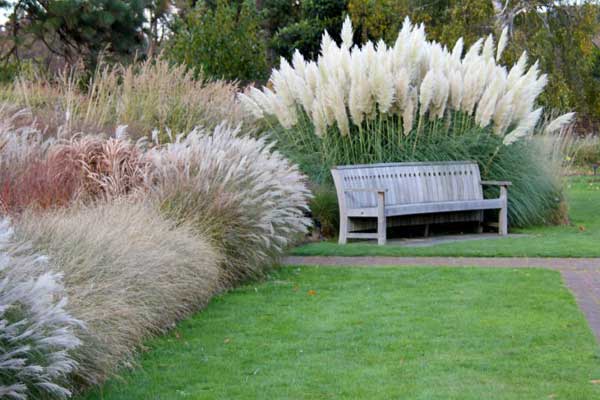Prime
How to grow ornamental grasses

The grass is not always greener, particularly when you look at the amazing ornamental varieties that are available. Photo / Net.
What you need to know:
- Ornamental grasses are a brilliant natural solution for linking formal parts of the garden to the surrounding countryside.
If you are wondering how to grow ornamental grasses in your garden, they are an easy way to add excitement to any planting scheme. An environmentally friendly garden idea, they need no staking, dead-heading or spraying, so footfall levels throughout the borders are kept low and new wildlife habitats can develop safety, while the seeds feed the birds.
And whatever the conditions in your garden, you can find a species that thrives. Anemanthele lessoniana, for instance, will flourish in dry shade and never needs watering. Bothriochloa Bladji likes well-drained soil in full sun, while Deschampsia can cope with heavy clay.
Grasses are a lovely choice if you are looking for flower bed ideas with a difference, as they create a variety of wonderful effects. From the tall, arching Calamagrostis, which evokes the atmosphere of a cornfield, to the smart, ground-hugging Hakonechloa, which is ideal for shade, pots and formal schemes.
For transparency, choose Molinia or, for a small patch of ornamental lawn or even a roof, look at the unassuming, Sesleria ‘Greenlee’, which is a new hybrid of S. caerulea and S. autumnalis. They can be sown directly in open ground where they are to flower. They will perform best in an open, sunny position. In order to rejuvenate grasses it is a good idea to divide them, but it is important to do this at the right time of year. If you are buying plants directly from garden nurseries, try getting them around spring so they can be planted directly into the ground.
Why choose ornamental grasses?
The grass is not always greener, particularly when you look at the amazing ornamental varieties that are available. They come in vibrant colours and sumptuous textures that delight throughout the year. Many develop into ground-hugging hummocks, making them great weed suppressants.
Consider adding them to a rock garden, or replacing a tired lawn in a small backyard, for example, with a no-mow carpet of shorter ornamental grass.
Evergreen varieties give year-round cover and little room for the unwanted plant invaders to squeeze through. Ornamental grasses not only add movement but also bring a pleasing musical note to the garden as they rustle and gently sway in the breeze.
Are ornamental grasses easy to grow?
Ornamental grasses are surprisingly easy to grow, no matter the condition of your garden. The unfussy form of ornamental grasses has made them a stalwart of the contemporary garden designer’s plant palette. They provide a seemingly endless variety of colour and texture. Plus they have see-through, wispy growth and swaying flowers that take on a magical quality when gilded with spider’s webs.
You will find perennials, such as verbascum or mulleins, poppies, day lilies and red hot pokers work best when planted in among a river of swaying grasses. Traditional gardeners like ornamental grasses too, mainly using them to stretch the interest in their cottage-style borders. For the best effect, and to update your flower beds, simply weave them alongside sedums, asters and heleniums, so that their spiky flowers contrast with the flat heads and daisy blooms of these late-flowering perennials.
Make sure you use the best-behaved clump-forming ornamental grasses, such as fountain grass or Pennisetum. Another good choice is Imperata cylindrica ‘Rubra’, producing blood-red spikes that fade to bright green at the base and become translucent by late summer. Plant it alongside the white-edged Hosta ‘Francee’ for good effect. Always be wary of vigorous spreaders, such as ribbon grass, which can take over.
What are the different types of ornamental grasses?
Coming in different shades of blue, gray, buff and gold, there is an ornamental grass for every situation. Taller varieties are ideal for fall borders, adding body, highlights and rhythm. Place them in the middle of a border if the grass is untidy, such as the elegant Calamagrostis brachytricha. Shorter ones will spill casually over the edges of containers, making them a great choice if you are looking for raised garden bed ideas. Most are tough, provided they do not become waterlogged, coping well in a sunny spot, in light soil.
Medium-sized varieties such as tufted hair grass (Deschampsia ‘Goldtau’) or pheasant’s grass (Anemanthele lessoniana) form fountain-like mounds of golden seedbeds. Adding body to herbaceous borders, the grassy clumps also support summer’s slender-stemmed plants; verbascum, or astrantias, for example. Fully developed seedbeds add an ethereal haze between bright perennials such as asters, rudbeckias, and sedums, creating cohesion between contrasting elements.
How do you care for ornamental grass?
Ornamental grasses add a light, airy touch to garden borders and provide a beautiful foil for more colourful and vivacious plants. Many can be left alone but if they are starting to look a bit bedraggled and battered, they will need cutting back in order to grow well and look their best. Remove the seeded stems with sharp, clean secateurs, taking care not to damage any new growth. Then cut the rest back to a few centimetres from the ground, leaving just a hairy tuft. Weed around the clump, and mulch well to feed the plant as it comes back into growth.
Some deciduous species, including Deschampsia and Calamagrostis, should be trimmed before new growth emerges.
Late pruning is also beneficial for Miscanthus, whereas the deciduous Stipa tenuissima can be treated as you would an evergreen grass, and be cut back now. Evergreen grasses such as blue fescue (Festuca glauca) just need a trim, so snip off brown tips and remove dead leaves from the base.
The key to success with ornamental grasses is not to move them too much. This is a common mistake with ornamental grasses that can send them into shock, although some do transplant better than others.
Sun or shade?
Ornamental grasses are split into two main groups. Firstly, taller deciduous varieties, which thrive in the sun and have lovely seedbeds. Secondly, shorter evergreens, including carex varieties, grow well in damp, shaded conditions, and Hakonechloa macra, cope in dry shade, making them a great choice if you are looking for garden shade ideas. The other group includes tall grasses such as Molinia, Miscanthus, Stipa and Panicum, which flourish in sunny, open spaces, looking their best when they erupt into a haze of burnished spikelets.
Source: homesandgardens.com




